A brief summary of the mineral occurences and geology of Monte Bianco
English
Castellano
Català
A brief summary of the mineral occurences and geology of Monte Bianco
Author: Marco Macchieraldo
Content by courtesy of : Marco Macchieraldo Minerals
Reproduction of text and photos prohibited without permission of author.
Special thanks for this article go to A.C., a cristallier of Chamonix, Savoie Department, France. In the summer of 2001 he helped me find nice specimens and gave much knowledge of climbing Monte Bianco, locating, and collecting fissure specimens. Without his help this paper would not have been possible. And thanks go to D.D., of the U.S.A. for his help in fine tuning the English translation of this Article. Neither wish to be mentioned out of modesty so only initials are used.
NOTE. This page is photo intensive and can be slow to load. If some photo is not complete please reload the page.
INTRODUCTION
Monte Bianco and adjacent regions, a famous European Alpine mineral occurrence locality has yielded a variety of mineral species, including quartz and fluorite specimens which are among the finest in the world. Mineral specimens from Monte Bianco are sought after and prized by museums and collectors from around the globe.
The Alps are the largest mountain system in Europe. The towering snow-capped peaks and peaceful valleys make them one of the most spectacular sights on the European continent.
The Alps extend northward from near the Mediterranian Sea in France and form the border between France and Italy. They continue eastward through northern Italy, Switzerland, Liechtenstein, southern Germany, Austria, and Slovenia. The entire mountain system is about 1,200 km (750 miles) in length. At their widest point, between southern Germany and northern Italy, the Alps are are about 260 km (160 miles) wide. At their narrowest point, they cover about 48 km (30 miles) in the Ligurian Alps of northwestern Italy.
Monte Bianco, at 4810 meters (15,800 feet) above sea-level, is the highest mountain peak in the Alps system and is also one of the most famous geological sights in Europe, along with the Matterhorn, another famous mountain rising to 4,478 meters (14,692 feet) above sea-level forming the border between Valais, Switzerland and the Valle dAosta region of Italy.
The ruggedness and altitude of the Alpine mountain system make travel so difficult, its presence has had an impact on human cultural development. More than 2,000 years ago few people made the difficult trip through the mountains. At that time the Roman Empire had already developed a great civilization south of the Alps, but the culture of the people north of the mountains remained largely undeveloped. About two millenia ago the Romans built roads through several Alpine passes, and as a result, communication across the mountains increased. Only then did the Northern Peoples of Europe develop more sophisticated cultures, based upon rules and law replacing force as a means of conflict resolution.
GEOGRAPHY AND TOPOGRAPHY

The geographic boundaries of Monte Bianco toward the northwest extend into the deep Chamonix Valley, department of Savoie, France; toward the southeast the mountain and surrounding features extend into two valleys near Courmayeur, Italy: Val Ferrret and Val Veny. Toward the northeast Monte Bianco reaches into the Swiss region of Martigny. The French and Swiss sides are part of the hydrographic drainage system and basin of the river Rhone. The Italian regions of Monte Bianco is in the hydrographic drainage system of the river Po.
In this massif there are numerous mountain peaks higher than 4,000 meters above sea-level:
- 4014 meters - Dente del Gigante
- 4206 meters - Grand Jorasses
- 4248 meters - Mont Blanc du Tacul
- 4306 meters - Dome di Gouter
- 4810 meters - Monte Bianco
There are many large glaciers on Monte Bianco, most of which are located on the French side of the mountain. Mer de Glace, Glacier des Bossons, Glacier du Talefre', Glacier de Leschaux, Glacier d'Argentiere, and Glacier du Tour are significant glaciers on the French side of the mountain. But there are large glaciers on the Italian slopes of Monte Bianco as well, such as Glacier of Miage, Glacier of Brenya, Glacier of Brouillard, Glacier of Estellette, Glacier of Triolet, and Glacier of Pre du Bar.
In the following photos majestic views from the Monte Bianco massif.

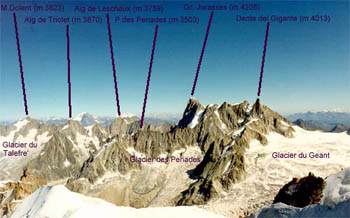
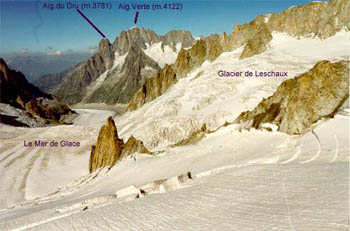
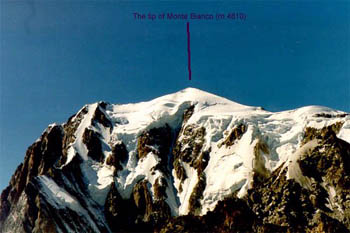

COLLECTING
Most of Monte Bianco and the surrounding regions are very difficult to reach because of the rugged terrain making travel by any means strenuous, slow, and dangerous. Accordingly, it is estimated that today only 18% of this region has been systematically explored. The remaining 82% is virgin mineralogical territory, located in the heart of Europe!
Furthermore, consider the strong erosional forces at work on Monte Bianco! Every winter there are avalanches and landslides. The expansion of the mineral water as it crystallizes at 0 degrees Celsius in the cracks and crevaces fractures rock as sure as explosives, only more slowly. With the arrival of springtime warming there is snow and ice melt run-off reshaping the mountain surfaces, along with the cold induced rock fractures, new parts of the great massif are exposed.
Typically the season of mineral collecting is limited to 2 or 3 months annually, and in many years there is no collecting done at all because of inclement weather during the 8 to 12 week window of mineral collecting. Clearly, Monte Bianco is not a site for the casual Sunday afternoon mineral collector. Only those with the knowledge, skills, and experience of Alpine mountain climbing equipped with "state of the art" climbing gear, and able to dedicate weeks or months of time can afford mineral collecting expeditions on the "White Mountain". There is a group of mineral collectors who have the needed abilities to attempt higher elevation collection. They are referred to locally as "cristalliers." These tough and rugged collectors risk their lives climbing to walls of rock searching for and removing the beautiful crystal specimens of Monte Bianco. No money received can pay for their efforts and risks. Something else must motivate the cristalliers. Perhaps it is living life at the edge, the exillaration of the climb, and a passion for crystal specimens. I would not be surprised if the finest specimens are part of the cristalliers collections.
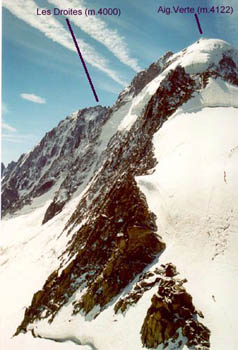
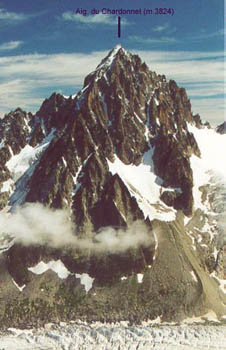
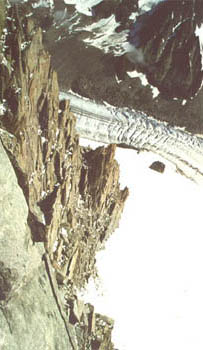
In the above photos you can see typical places where you can find alpine fissures. Here you can have an idea about difficulties and dangers to find them.
For those less adventurous than the cristalliers, at the lowest altitudes of Monte Bianco, mainly in the morenic outwashes deposited by the glaciers, it is possible to find good mineral at these locations as well. The rocks and minerals trapped at the bottom of the glaciers are less likely to produce fine crystallized specimens because of the intense erosional forces of water flow and abrasion with the underlying granite massif. There is another process which allows fine crystal specimens to be found at these same moraines. In winter rocks are split, cracked, and detached from the mountain surface. A few of these fall onto the surfaces of the many glaciers with fine crystalline specimens undamaged. These rocks, being darker in color than the surrounding ice and snow, absorb more solar infrared electomagnetic radiation and are warmed sufficiently to melt adjacent ice and become engulfed in the glacier, isolated from hydrologic or abrasional erosional forces. In due time these rocks are at the terminus of its host glacier and drop relatively gently out of the ice and are deposited in the morenic outwash materials without having been exposed to the abrasion and hydrologic erosion of the sub-glacial rock fragments.
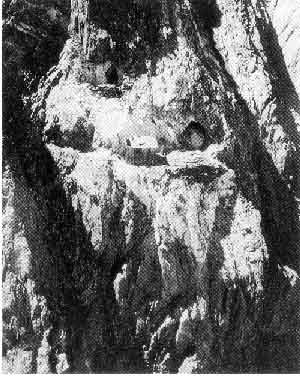
Some fine specimens can be found at the lower elevations by these means of transport. As a general rule, the southwest regions are rich in the more uncommon to rare mineral species. In Contrast, the northeast regions yield few of the rare occurrences, but yield large and spectacular specimens of the more common minerals. Outstanding, fabulous smokey quartz and pink fluorites can be found in this area.On the Italian side of Monte Bianco there is an occurrence of argentiferous galena. It has not been found elsewhere in the region, except in this Italian locality at the "Mine of Miage", located 3,500 meters altitude. It has been closed since the 19th century, and in the time of its operation, it was mined from 3 to 4 months per year because of the inhospitable climate. The miners slept in the mine rather than the huts provided to them because of the many avalanches. On the left an old black & white photo of the mine. It's possible to see the two entries of the galleries.
GEOLOGY
Approximately 300 million years ago during the Ercynic Orogenisis, a huge granitic intrusion formed the structural base of the Monte Bianco region. Geologically recently, about 70 million years ago, a new mountain building event, the Alpine Orogenesis, uplifted the older granitic intrusion, creating many cracks and fissures in the massif. This uplifting of the Alpine Orogenesis continues to this day, but at a time in the past there was an ejection of hydrothermal fluids through the fissures. With slow cooling of these fluids mineral crystals, sometimes spectacular, grew within the cracks and fissures of Monte Bianco.
The processes leading to the growth of wonderful quartz crystals within the fissures is partially understood. Nuclear Isotope dating applied to contemporaneous Orthoclase, variety: Adularia ( nearly pure KAlSi3O8 - Potassium Aluminum silicate ), suggest that the hydrothermal ejection and subsequent growth of fissure crystals occurred approximately 18.5 million years ago. Some quartz crystals called enhydros contain fluid inclusions containning the fluids ejected at the time of their growth - 18.5 million years ago. Analysis of the fluid inclusions help to determine the thermodynamic conditions, and suggest that the pressure and temperature allowing growth of the Monte Bianco quartz crystals occurred at a depth of nearly 16 kilometers and at a temperature of nearly 400 degrees Celsius. During uplift of the overlying Ercynic rock, the granite became brittle from the underlying Alpine Orogeny forces, stretching the granite. A system of cracks and fissures developed.The super-heated water and solutes was immediately injected into the fissures, cracks, and voids as they formed. The color of the quartz are a result of the combined actions of molecular substitution by cations from the granite matrix replacing silicon in the quartz crystalline lattice and the effects of radioactive elements in the surrounding granite.
The paragenisis of the fissure mineralization is relatively simple. The succession observed: epidote, quartz, adularia, fluorite, chlorite, calcite, and a series of less frequent mineralizations - hematite, galena,etc.
Some studies of the growth of Monte Bianco quartz conclude that it was a speedy process of months or years before changes in the chemical equillibria quickly stopped crystallization.
A fluid pressure of 380 Mpascal is necessary to crystalize quartz, which is near the pressure 16km subsurface. Considering the crystals are 18.5 million years old, it can be calculated that a median lifting of Monte Bianco during the Alpine Orogeny is 0.9 mm per year.
MINERALS
Quartz and Fluorite are the mineral soverigns, the royalty, of Monte Bianco, producing specimens of exceptional quality, prized by collectors around the world. There are, of course, many, many other mineral occurrences from Monte Bianco and the surrounding regions. Following the more detailed Quartz and Fluorite descriptions is a partial list of Monte Bianco mineral occurrences, some with notations.
QUARTZ ( SiO2 )
As a general rule, Monte Bianco quartz crystals are stocky and of a medium size, typically ranging from 3cm to 10cm. The largest crystal discovered to this date is one of 40cm in length and they usually exhibit a macromosaic structure as a result of growth of subparrallel multiple crystals. In fissures they are often found detached from the granitic matrix because of tectonic movements, often after crystallization. Some crystals occurrences exhibit recrystallization after tectonic fracture. These are of particular interest and beauty as well.
When a crystallized pocket is located, it is often relatively easy to remove and collect the quartz crystals with the use of ones' hands and a small pry bar. To find a crystallized pocket is not so easy at all. A significant impediment is the location of the crystallized fissures, typically at altitudes of 3,000 to 4,500 meters above sea-level (approximately 10,000 to 15,000 feet), and frequently on surfaces sloping from 60% to 95% inclination from horizontal toward 90 degrees vertical. Adding to the difficulty of accessing crystallized fissures is because the surrounding rock is almost always very fractured with loose chunks, making secure footing difficult and dangerous. Many cristalliers have died from rockslides and avalanches attempting to collect these crystal fissures.
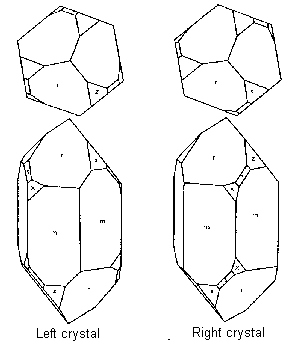
Crystal morphology of Monte Bianco quartz exhibits the usual Right or Left crystal forms. The figure on the left is a diagram showing the Right and Left crystallization habits.
Dauphine's Law crystals are relatively common at Monte Bianco. This is a crystal twinning habit observed in quartz (and some other hexagonal system minerals) in which two right handed or two left handed crystals interpenetrate after one has revolved 180 degrees about the twinning axis.
Brazil twin crystallization is rare. This is a crystal twinning habit in which the two crystals are of opposite handedness, one being right and the other left,with a face of the trigonal prism of the second order as the twinning plane. Since one is not derivable from the other by any rotation, there is no twinning axis.
Japan Law twinning, an uncommon type of quartz crystallization twinning in which in which two portions are symmetrical with respect to a trigonal bipyramid of the second order, has never been observed in quartz from Monte Bianco.
Typical of the Mount Bianco locality, but very rare and researched are the Gwindel quartzes. They result from parrallel growth on matrix of biterminated crystals. But the main axis of the crystals are rotated and form a helicoidal form of crystal. This crystal habit is named "peigne" in France, "gwindel" in Switzerland, and "elicoidali" in Italy. Study suggests that this unusual form of crystallization is caused by pyroelectricity during crystal growth when positive and negative electrical charges develop simultaneously on different parts of the same crystal in response to temperature changes suitable to evoke this electrical phenomenon. In the following drawings the growth of a gwindel quartz from the closed to the open form is explained.
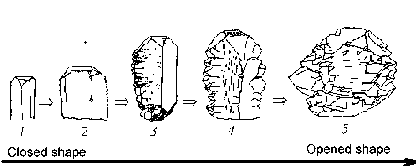
The size of the gwindel specimens are generally not large, and the torsion angles range from a few degrees to an exceptional specimen with a torsion angle of 66 degrees which was found on the Aiguille Croulante near the Argentiere glacier in the northeast region of Monte Bianco.
Another interesting crystal habit of quartz is called the Scepter crystal form. In the Monte Bianco region the scepters are very rare, found less frequently than the gwindel crystals. The scepter quartz is found in only a single location in the entire region, like the gwindels, near the Argentiere glacier. Most scepter crystals have a violet amethestine color. This crystal form develops when there is a secondary recrystallization on the termination of existing quartz crystals of typical form with tardive fluids rich in copper salts.
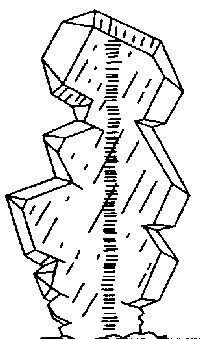
Called "a ame" by the cristalliers, another quartz crystal habit found at Monte Bianco is the Faden crystal. These are relatively common and result from the parallel growth of plate biterminated crystals without torsion angles. The fadens are similar to the gwindels, but besides having no torsion angle, the fadens always exhibit ghosts, or phantom of earlier crystallization inside the crystal. On the left a draft with a sample of them.
The quartz specimens of Monte Bianco exhibit a range of from colors the ialine, perfectly clear transparent to black, with a continuous series of all shades of smokey quartz specimens between the two end members. The brilliance is exceptional. Even the darkest of crystals have a brilliance and transparency. I consider the quartz crystal ossurrence of Monte Bianco to be of the finest quality in the world. To add an attractive color and textural contrast, many specimens have a light coating of green chlorite on some of the crystal faces creating an esthetically pleasing effect.
Crystals exhibiting color, always have the greatest intensity of coloration at the base of the crystal. This habit is the result of two phenomena: 1.) Atomic substitution of cations for silicon in the quartz crystal lattice is more likely at the base of the crystal because of its proximity to the granite matrix to which the base of the crystal is attached, and, 2.) natural radioactivity. The structural impurities present are typically a substitution of atoms of silicon (valence +4) by aluminum (valence +3) and either hydrogen (valence +1) or lithium (valence +1). These atomic substitutions are only potential color altering centers. These must be activated by high energy short wave electromagnetic radiation, from x-rays to gamma-rays. The source of the natural radioactivity is the Monte Bianco granite which has a relatively high content of uranium (approximately 0.10 to 0.25 g/kg) and thorium (approximately 0.25 to 0.40 g/kg).
The occurrence of the many shades of quartz at Monte Bianco is also related to the altitude at which the crystals are found. This is a curious pattern which is observed. Geological experiments and studies of activation of color centers by high energy radiation explains this unusual distribution of crystal colors as a function of the altitude in which they are found. It has been demonstrated experimentally that color centers are activated at temperatures less than 225 degrees Celsius. (Keep this in mind for the moment). Quartz crystals found below 2,400 meters altitude are colorless, brilliant, and transparent as glass. Above 2,400 meters to 4,000 meters in altitude the quartz crystals are a smokey color, with the intensity of coloration increasing in direct proportion to the proximity of crystal location toward an elevation of 4,000 meters. At elevations above 4,000 meters above sea level, the quartz crystals are black and called morion quartz crystals. ( I want to note that to my knowledge, none of the Monte Bianco quartz crystals are artifically irradiated to darken crystal otherwise lighter in color.).
Since the beginning of the Alpine Orogeny, Monte Bianco has been uplifting, and continues to this day. The rock, and its fissures containing quartz crystals, at the highest elevations were cooled the more deeply seated granite. Therefore, the higher altitude quartz cooled to the transitional 225 degree Celsius (mentioned above),temperature at which the coloration centers can begin to be activated. The crystals of higher altitudes have been colder longer than the crystals at lower altitudes!
XX = Crystal XXs = Crystals

Gwindel smokey quartz Aig. de Leschaux (west side) M.Bianco - France. Size 11x10x5 cm. Typical smokey gwindel right quartz perfectly transparent. Torsion angle 35 degrees.
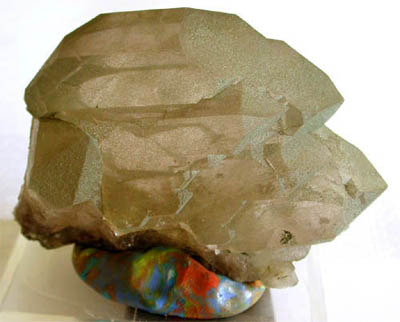
Gwindel quartz Pointe des Periades (east side) M.Bianco - France. Size 10x8x4 cm. Typical gwindel right quartz partially covered with chlorite. Torsion angle 10 degrees.
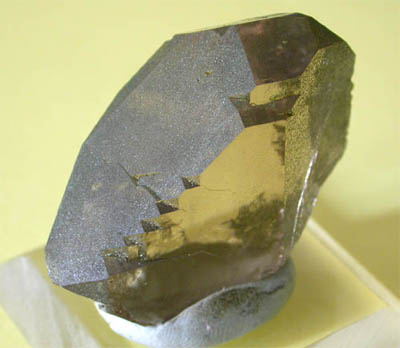
Gwindel smokey quartz Pointe Isabelle (west side) M.Bianco - France. Size 5x4x2 cm. Typical smokey gwindel right quartz in the closed shape at the beginning of the growth. Perfectly transparent.
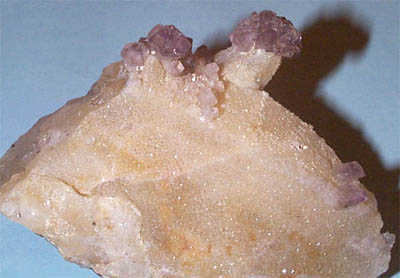
Quartz var. amethyst Aig. de Triolet (west side) M.Bianco - France. Size 11x8x5 cm. Incredible groups of violet scepter XXs on white quartz.
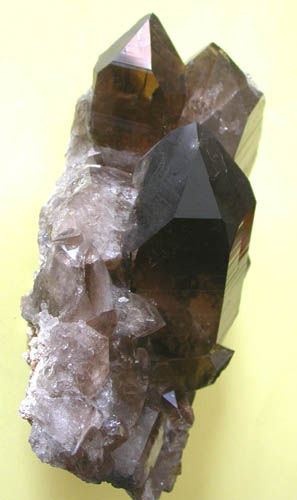
Smokey quartz Les Droites (north side) M.Bianco - France. Size 15x9x7 cm. Group of brilliant dark-smokey XXs with max. size 80 mm and perfect terminations. Its very evident the main crystal is left.

Black quartz (morion) Aig. Verte (north side) M.Bianco - France. Size 11x9x5 cm. Incredible group of black beautiful XXs with max. size 95 mm.
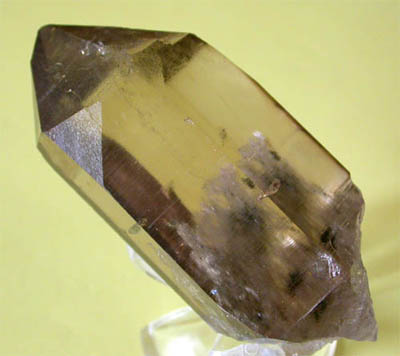
Smokey quartz Glacier of Triolet Monte Bianco Val dAosta Italy. Size 9x4x4 cm. Big single biterminated left crystal with execeptional transparence and beautiful ghosts inside.
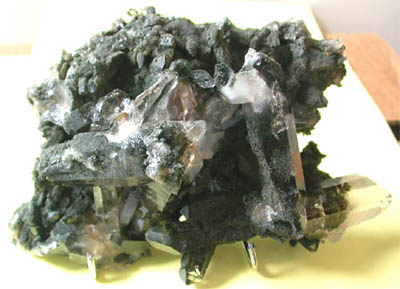
Quartz with chlorite Le Contamines M.Bianco south - France. Size 17x11x6 cm. Group of colourless XXs with max. size 70 mm. heavily encrusted with dark green chlorite. From a finding of 2001 year in the south part of massif.
FLUORITE (CaF2)
The fluorite occurrences at the Monte Bianco massif are among the jewels of Alpine mineralogy, with the pink fluorites the most spectacular. Deposits of pink fluorite are found in Alpine clefts, and are very rare. The pink variety of fluorite, caused by inclusions of the REE Yttrium within the crystal, can also be found in pegmatites in Pakistan, Poland, and the metalifferous deposits of Huanzala, Peru. For collectors of mineral combinations, the Monte Bianco pink fluorite octahedra on smokey quartz, being recovered for three decades now, are considered by their freshness and aesthetic appeal are considered to be among the worlds most attractive mineral combinations, surpassing a number of Swiss specimens (from locations other than the Swiss portion of Monte Bianco) which previously held that honor.
The pink fluorites are rare and found in octahedral groups on smokey or morion quartz.. Pink fluorite octahedral aggregates can also be found directly on the granitic matrix. Other crystal forms of fluorite are very uncommon. Many of the pink fluorites, being a softer mineral, show the corrosional effects of ice and have a satin surface on the crystal faces with some rounding of the corners. The pink fluorites are usually from a light pink to a deeper strawberry red in color. Some light green fluorites can be found but are rare, and an interesting and attractive green fluorite with a pink center can be found on Monte Bianco.
The Monte Bianco fluorites come in a wide range of sizes, from a few millimeters to exceptional octahedral giants of 20 cm in size. This largest specimen was found by George Bettembourg in 1982 and is now in the Mineralogy Museum of Chamonix. The most recent important discovery of fluorites was in 1997 by Danielle Lagarde on the Tour Noir in the Argentiere glacier.
There is another unusual feature regarding the most beautiful specimens of Monte Bianco fluorites. This curiosity is one of human nature, not of the nature of minerals. This is the fact that that the finest fluorites have a name --- the same name as its discoverer. So, there is one specimen of granite matrix of 25cm with a perfect morion quartz in the center surrounded by many red fluorites of 4 to 5cm. The name of this spectacular specimen is "Amedee" after its discoverer; and an octahedra of pink fluorite to 18cm on edge named "George", discovered by.............etc.
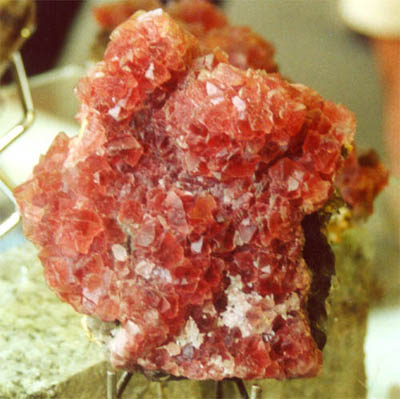
Red fluorite Tour Noir M.Bianco - France. Size 12x12x5 cm. Beautiful carpet of red octaedric XXs with max. size 20 mm. on matrix. (from the Chamonix Mineral's show 2001).
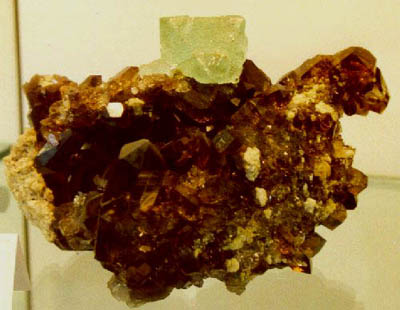
Green fluorite on black quartz Les Courtes M.Bianco - France. Size 20x12x8 cm. Exceptional and wonderful specimen find in 1992 with a big perfect octaedric green XX of 40 mm. on black quartz XXs. (Collection Mineralogical Group of Chamonix).
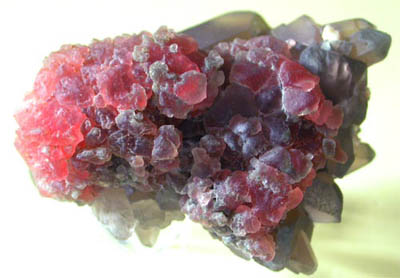
Red fluorite on smokey quartz Tour Noir M.Bianco - France. Size 7x5x4 cm. Group of red octaedric XXs partially corroded with max. size 8 mm. on smokey quartz XXs.
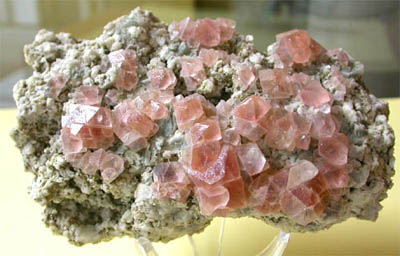
Pink fluorite Aig. du Chardonnet M.Bianco - France. Size 11x7x5 cm. Group of exceptional pink octaedric XXs with max. size 16 mm. on granitic matrix.
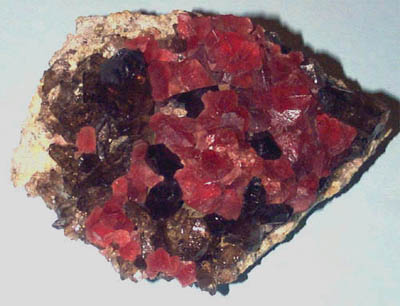
Red fluorite on smokey quartz Glacier d'Argentiere M.Bianco - France. Size 14x12x6 cm. Group of exceptional red octaedric XXs with max. size 25 mm. on smokey quartzs XXs.
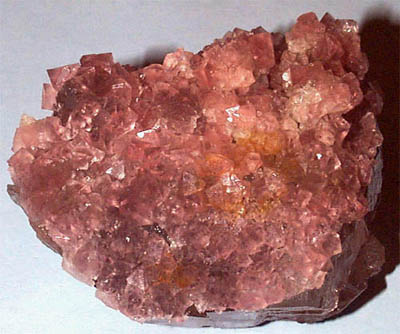
Pink fluorite Glacier d'Argentiere M.Bianco - France. Size 8x7x5 cm. Carpet of pink transparent XXs with max. size 10 mm. on smokey quartz matrix.
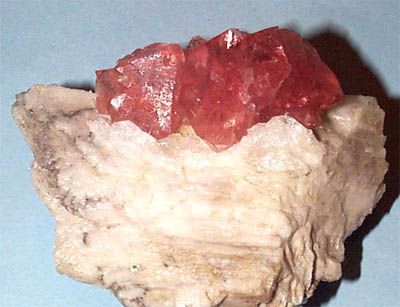
Red fluorite M. Mallet M.Bianco - France. Size 6x5x3 cm. Group of perfect red octaedric XXs with max. size 30 mm. on calcite matrix.
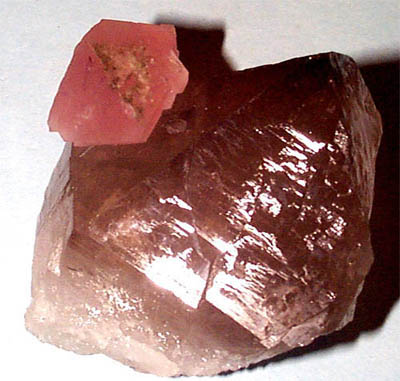
Red fluorite Glacier d'Argentiere M.Bianco - France. Size 5x5x3 cm. Red octaedric single XX of 20 mm. on smokey quartz.
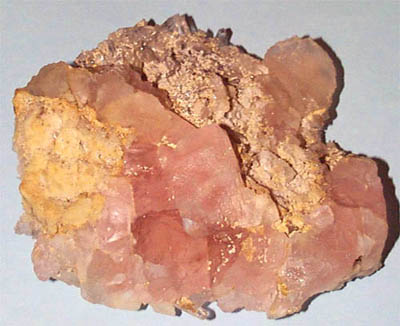
Pink fluorite Dente del Gigante M.Bianco - Italy. Size 11x10x3 cm. Group of light pink XXs with complex forms partially corroded. Very rare specimen from the Italian side of Monte Bianco.
Other Minerals
Adularia (K,AL.Si3.O8)
This variety of orthoclase is relatively common in all areas of the massif. These opaque white crystals are frequently with a druse of green chlorite. Crystals to 2cm are found.
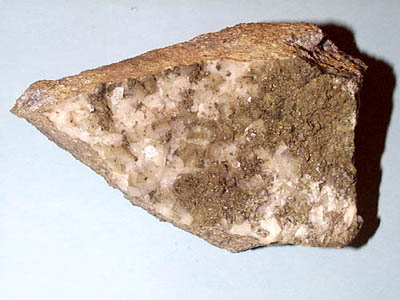
Orthoclase var. adularia Glacier of Miage - M.Bianco Val dAosta - Italy. Size 10x7x4 cm. Group of white romboedric XXs with max. size 5 mm. on granitic matrix partially covered with green chlorite.
Aeschynite-Ce (( Ce, Ca, Fe, Th),(Ti, Nb)) . 2 (O,OH)6
A rare mineral occurrence, this REE mineral is found at Monte Bianco as beautiful red-brown prismatic crystals to 5mm on granitic matrix. Aeschynite-Ce occurs mainly in the area of Miage Glacier on the Italian side of the mountain.
Albite ( NaAlSi3OH8 )
This is a relatively common member of the feldspar group of minerals and can be found as white to colorless tabular crystals to 2cm associated with quartz throughout the region.
Anatase ( TiO2 )
Beautiful and flawless bipyramidal crystals of anatase to 1.0 cm are found in the Miage Gacier on the Italian regions of Monte Bianco. The color is usually black, yet translucent. Having a refraction angle greater than that of diamond, producing especially brilliant crystals, many consider these anatase among the most beautiful and elegant minerals in the smaller size class.

Anatase with apatite Glacier of Miage - M.Bianco Val dAosta - Italy. Size 6x4x3 cm. Group of black brilliant XXs with max. size 4 mm. with colourless apatite XXs on chloritic matrix.
Ankerite (Ca (Fe++, Mg,Mn)(CO3)2)
A relatively common mineral, occurring throughout Monte Bianco, white to brown crystals can be found. These are not particularly exceptional or aesthetic specimens of this species.
Beryl (Be3 Al2 Si6 O18)
Beryl can be found as microcrystals at Aguille de Charmoz, on the French side, and at Glacier de la Brenva on the Italian side of Monte Bianco. Note that this is a typical pegmatite mineral, but in the Monte Bianco region there are no pegmatites, only hydrothermal Alpine fissures within granite of smaller crystallization than found in pegmatites.
Brookite (TiO2)
Occurs as tabular red crystals in the Italian regions of Monte Bianco. Chemical composition of brookite is identical with anatase and rutile.
Byssolite ((Ca2)(Mg,Fe++)5)(Si8O22(OH)2)
This variety of actinolite is found as beautiful carpets of olive green fibers to 50mm on granitic matrix, or on ialine, glass-clear quartz crystals.
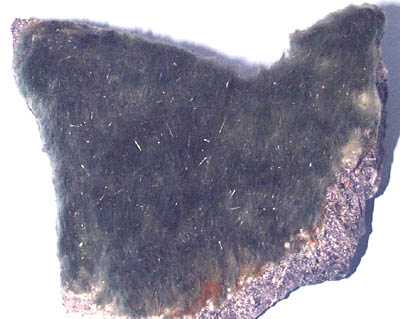
Calcite ( CaCo3 )
Calcite is a common mineral occurrence in the entire Monte Bianco region, with crystals in several of the many calcite crystal habits. Found are lenticular lenses, scalenohedral, hexagonal, and rhombohedral prisms. Of particular interest are the calcite crystals exhibiting different crystalization forms on the same specimen.
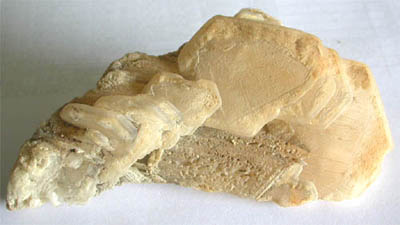
Calcite Pointe Kurtz M.Bianco - France. Size 10x5x3 cm. Group of white hexagonal XXs with max. size 40 mm.
Chabazite [(CaO5,K,Na)4 (Al4SiO8)24].[12 H2O]
This zeolite is very rare at Monte Bianco. Many years ago exceptional white to colorless crystals with a pseudocubic form up to 20mm were found at the Glacier of Miage in Italy.
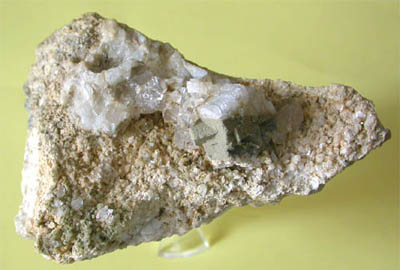
Chabazite with quartz Glacier of Miage M.Bianco Valle dAosta - Italy. Size 12x8x8 cm. Group of white pseudocubic intersected XXs with size 22 mm and colourless quartzs on granitic matrix.
Chlorite
Chlorite is a general term for a group of hydrated silicates of aluminum, iron, and magnesium, with a general formula (Mg,Fe)5 Al(AlSi3) O10. The chlorite group is very common throughout the massif. The generally small crystals encrust or coat many crystal or crystal faces of many quartz, fluorite, adularia and other minerals, creating a nice aesthetic effect with its green color as contrast to the host mineral.
Dolomite (Ca,Mg)(CO3)2
Dolomite is relatively common in all regions of the massif, forming crystals not particularly aesthetic.
Epidote { (Ca2(Fe+++,Al) 3(SiO4)3(OH) }
Druses of very small green crystals are common. However, exceptional crystals of 20mm and greater can be found. It's normally mixed with quartz and byssolite.
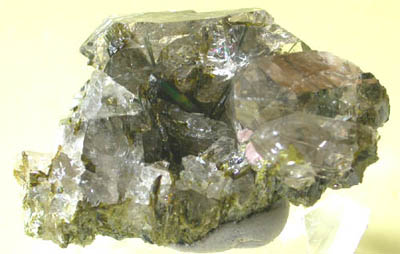
Quartz on epidote Glacier of Miage M.Bianco Valle dAosta - Italy. Size 5x4x2. Group of a biterminated colourless quartz XX of 35 mm. and other smaller ones on a carpet of dark green epidote XXs with max. size 10 mm.
Ferroaxinite (Ca2 Fe++ Al2 BO) 3 (SiO4)12(OH)
A unique finding of exceptionally attractive ferroaxinites was discovered many years ago on the Miage Glacier. Specimens of to 20mm were found.
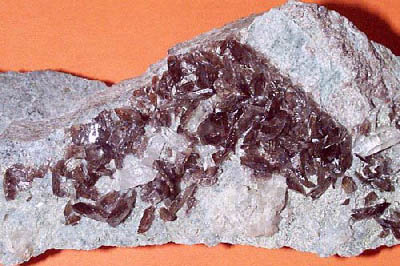
Axinite Glacier of Miage Monte Bianco Valle dAosta - Italy. Size 18x7x4 cm. Group of very brilliant brown XXs with max. size 12 mm. with small colourless quartzs.
Fluorapatite (Ca5 (PO4)3F)
An exceptional crystal was found on the Pointe Isabelle ( Bassin d' Argentiere). Other very nice colourless or pink crystals can be found on the Italian side near the Glacier of Miage.
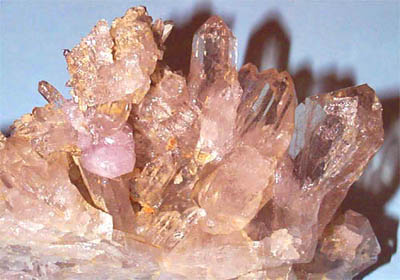
Pink Apatite on quartz Piccolo M.Bianco M.Bianco - Italy. Size 14x10x6 cm. Exceptional hexagonal pink XX of 15 mm. on a group of colourless quartz.
Galena (PbS)
Massive galena, essentially non-crystallized, is the lead ore from the old Miage mine.
Hematite (Fe2O3 )
Beautiful specimens from glacier d' Argentiere have been found on the French side. Monte Bianco produces very rare hematite crystallized in the iron rose habit and associated with pink fluorite and quartz. These iron roses are found to 10mm.
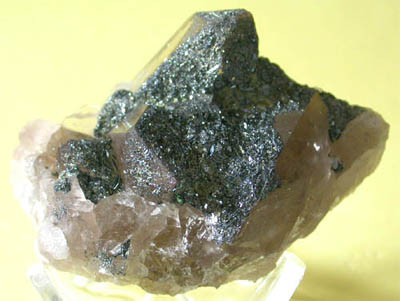
Laumontite (Ca4 [Al8Si16O48].18 H2O)
Interesting specimens to 20mm were found many years ago from the Glacier d' Argentiere.
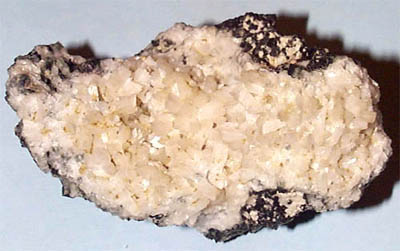
Laumontite Glacier of Miage M.Bianco - Italy. Size 8x6x6 cm. Carpet of white XXs of 10 mm. on matrix.
Molybdenite (MoS2)
In brilliant masses, molybdenite is relative common in the granite matrix.
Native Gold (Au)
Native gold is very rare, but there are 3 documented occurences. In 1950 gold was found as inclusions in quartz on the French regions of Monte Bianco. In 1956 gold was found on the Italian side of the mountain as nugget. The third gold occurrence was found in 1971 on the Miage Glacier as dendritic coatings or inclusions in smokey quartz.
Scheelite (CaWO4)
The Swiss regions of Monte Bianco produces interesting crystals to 20mm of this very rare mineral occurrence in this area.
Siderite (Fe++ CO3)
Lenticular crystals to 20mm in size have been found on the French side of the massif on or near the Argentiere Glacier. These specimens are interesting and beautiful, making aesthetic specimens.
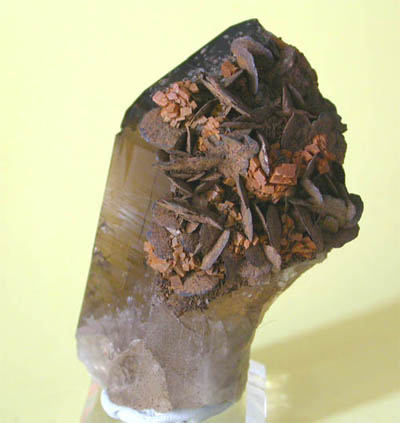
Siderite on smokey quartz Les Courtes M.Bianco - France. Size 8x5x4 cm. Smokey single quartz XX partially covered with a group of lenticolar brown siderite XXs.
Stilbite ((CaO5, Na K)9 (Al9 Si27 O72)-28H2O
This zeolite is very rare on Monte Bianco. Many years ago exceptional white crystals with spherical or sheaf forms to 20mm were found at the Miage Glacier in Italy.
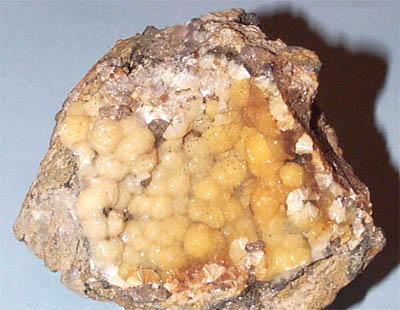
Stilbite Glacier of Miage M.Bianco - Italy. Size 8x8x6 cm. Carpet of yellow spheric XXs of 10 mm. on matrix.
Titanite (CaTiSiO5)
Relatively common occurrences on the Italian side of Monte Bianco. Yellow or pink crystals to 15mm in size can be found.
Content by courtesy of :
Information | Mineral photos | VIDEOS | Articles | Fairs | Web directory | Classified ads | Minerals Books | Shop






